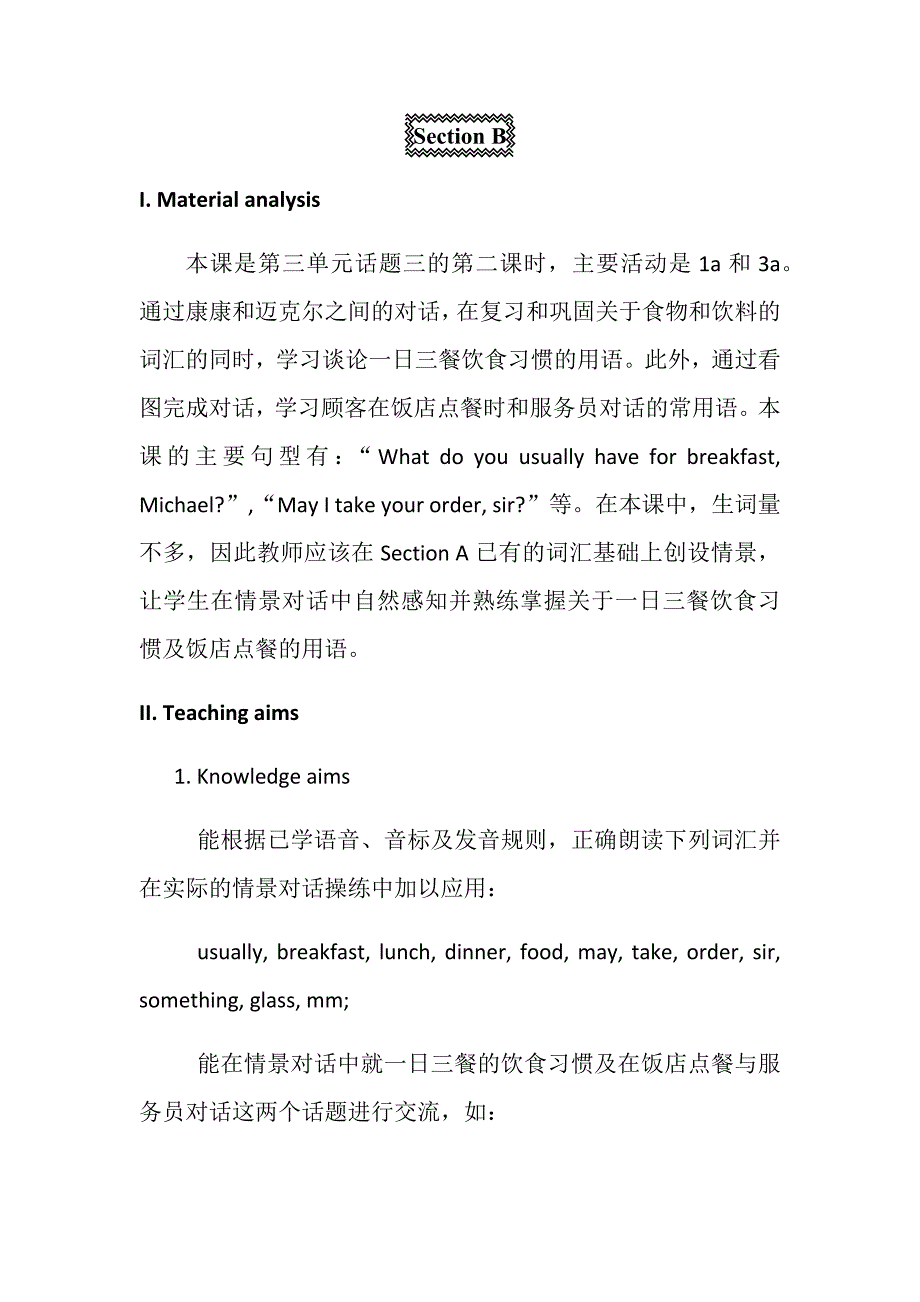 点餐教案
点餐教案



《点餐教案》由会员分享,可在线阅读,更多相关《点餐教案(17页珍藏版)》请在装配图网上搜索。
1、Section BI. Material analysis 本课是第三单元话题三的第二课时,主要活动是1a和3a。通过康康和迈克尔之间的对话,在复习和巩固关于食物和饮料的词汇的同时,学习谈论一日三餐饮食习惯的用语。此外,通过看图完成对话,学习顾客在饭店点餐时和服务员对话的常用语。本课的主要句型有:“What do you usually have for breakfast, Michael?”,“May I take your order, sir?”等。在本课中,生词量不多,因此教师应该在Section A已有的词汇基础上创设情景,让学生在情景对话中自然感知并熟练掌握关于一日三餐饮食习惯及
2、饭店点餐的用语。II. Teaching aims1. Knowledge aims能根据已学语音、音标及发音规则,正确朗读下列词汇并在实际的情景对话操练中加以应用:usually, breakfast, lunch, dinner, food, may, take, order, sir, something, glass, mm;能在情景对话中就一日三餐的饮食习惯及在饭店点餐与服务员对话这两个话题进行交流,如:(1)What do you usually have for breakfast, Michael? I usually have milk and bread for break
3、fast.(2)May I take your order, sir? Some fish with vegetables and a bowl of rice, please.在教师的帮助与指引下,通过对话操练、听力训练等活动, 能掌握for+breakfast/lunch/dinner的用法。2. Skill aims能听懂有关一日三餐饮食习惯及饭店点餐等的简单对话;能就一日三餐饮食习惯及饭店点餐话题进行交流;能正确朗读对话,注意语音语调;能根据图文理解有关就餐的对话与小短文,并根据要求进行学习活动;能根据图文完成有关就餐的对话填空。3. Emotional aims在学习过程中,创设真实
4、的情景,并采用小对话、小表演等灵活多样的授课方式,激发学生的好奇心和求知欲,培养学生学习英语的兴趣和积极主动的学习精神;鼓励学生积极大胆,敢于模仿,培养学生学好英语的信心;使学生乐于接触并了解中西方餐饮习惯的差别,同时养成良好的饮食习惯。III. The key points and difficult points 1.学生能在情景对话中,熟练运用谈论日常饮食及点餐的表达法。2.学生能结合课堂调查将同伴的饮食习惯用第三人称进行陈述。IV. Learning strategies1.能够清楚、大声地进行朗读,认真听录音和老师的发音,大胆开口,反复模仿。2.能够逐渐养成进行预习和复习的好习惯。V
5、. Teaching aids录音机、教学挂图、多媒体和黑板。VI. Teaching proceduresStepInteraction patternStudent activityTeacher activityIntroduction (5 minutes)1.The whole class work.2.Group work.3.Individual work and pair work.4.Individual work and pair work.1.Focus their attention on the teacher.2.Do duty report. Do brainst
6、orming. Sit in groups. Discuss in groups first. Then write down the words of food and drinks as many as you can on the blackboard. The group which can write the most words in certain time is the winner in this competition. After that, the whole class separate the words of food and drinks into two gr
7、oups: countable nouns and uncountable nouns.Countable nouns: bananas, vegetables, eggs, hamburgers, bananasUncountable nouns: water, milk, juice, rice, bread, chicken, fish3.Match the sentences in Column A with the ones in Column B. Then check the answers with your partners.Column A:Help yourselves!
8、Would you like some eggs?What would you like to drink?What about some.?Column B:Good idea.Thank you.No, thanks.Apple juice, please.4. Choose the correctsentences to complete the conversation individually. Then practice the conversation in pairs.e.g.A: Help yourselves!B:_.A: Would you like some rice,
9、 B?B:_. Id like some chicken.A: _, C?C: Orange juice, please.A: OK. Here you are._,B?B: Good idea!A: No, thanks.B: Thank you.C: What about some juiceD: What would you like to drink?1.Greet students ready for learning.2.Help the students to revise the words of food and drinks in Section A.3.Check the
10、 answers. Walk around and offer help if the students need.4. Check the answers. Correct the students pronunciation if necessary.Presentation (10 minutes)1.Individual work. 2.Individual work and pair work.1.Look at the pictures of clocks. Answer the teachers questions and learn the new words. T: What
11、 do you often/usually have in the morning/for breakfast?S1: I often/usually have milk and bread in the morning/for breakfast.T:What do you often/usually have at noon/for lunch?S2: I usually have rice and chicken at noon/for lunch.T:What do you often/usually have in the evening/for dinner?S3:I often/
12、usually have noodles in the evening/for dinner.2.Do 1b. Look at the picture in 1a. Predict the conversation in 1a. Then listen to the conversation and do 1b. Match the following pictures with each meal. The whole class checks the answers together. Then read 1a after the tape. Practice the conversati
13、on in pairs.1.Use the pictures to present the new words in conversations.2.Play the tape. Check the answers. Consolidation (5 minutes)1. Pair work.2.Individual work.1. Ask and answer questions according to 1b, talking about Michaels eating habits.A: What does Michaelusually have for breakfast?B: He
14、usually has milk and bread for breakfast.A:What does he usually have for lunch?B:He usually has chicken and rice for lunch.A:What does he usually have for dinner?B:He usually has jiaozi. Its his favorite food. He likes Chinese food very much.2. Do 1c. Read 1a again and fill in the blanks. Then repor
15、t it to the class.1.Make sure the students use “does” and “has” correctly.2.Check the answers.Practice(15 minutes)Individual work and pair work.2. Pair work and individual work.1. Do 3a. Look at the picture in 3a. Know the food and drink in the picture. Predict what the conversation in 3a is about.
16、Then complete the conversation. Check the answers in pairs. The whole class check the answers together. Then practice the conversation in pairs and report it to the class.2. Do 3b. Complete theconversation with correct sentences in 3b. Check the answers with your partner. Then practice in pairs. Act
17、 it out. Remember to act like a rabbit or a monkey.1. Help the students know the food and drink in the picture and pay attention to the sentence:May I take your order, Sir., please.Check the answers. Remind the students to use their body languages while acting the conversation.2.Check the answers. E
18、ncourage the students to pretend to be a rabbit or a monkey while acting out the conversation.Production (10 minutes)1.Group work. 1.Work in groups. Survey your group members about what they usually have for breakfast, lunch and dinner. A: Hello! What do youusually have for breakfast?B: I usually ha
19、ve.A: What about lunch?B: I usually have.A: And dinner?B: I usually have.Then fill in the form in 2.ABCDBreakfastLunchDinnerThen make a short report. This is my friend, Li Hua. He usually has. for breakfast. And . for lunch. He likes it very much. He usually has. for dinner. Its his favorite.1.Help
20、the students revise and consolidate the expressions about three meals and ordering in a restaurant in this section. Encourage the students to speak English loudly and bravely.2. Assign homework:Read 1a fluently and recite it;Review the words and expressions in this section;Do a survey about what you
21、r family members usually have for breakfast, lunch and dinner. Fill in the form and report it to the class next day;FMBBLDPreview Section C-1a.Teaching reflection: 这节课是对已学食物和饮料名词的再现和巩固,同时在此基础上,进一步学习谈论关于一日三餐的饮食习惯以及在饭店用餐时的点餐用语。学生在有例子的对话中进行套用训练会比较得心应手,但是在将调查结果用第三人称转述时易出现实义动词第三人称单数使用的错误,因此教师应该在学生汇报时予以纠正。此外,有的学生因为害怕发音错误,而不敢开口说英语,教师应鼓励其勇敢地开口说,从简单的对话操练开始,不断练习和提高口语水平。VII. Blackboard designWhat would you like to drink?Section B1. What do you usually have for breakfast, Michael? 2. What about lunch? 3. May I take your order, sir? usually breakfast lunch dinner food maytake order sir something glass mm
- 温馨提示:
1: 本站所有资源如无特殊说明,都需要本地电脑安装OFFICE2007和PDF阅读器。图纸软件为CAD,CAXA,PROE,UG,SolidWorks等.压缩文件请下载最新的WinRAR软件解压。
2: 本站的文档不包含任何第三方提供的附件图纸等,如果需要附件,请联系上传者。文件的所有权益归上传用户所有。
3.本站RAR压缩包中若带图纸,网页内容里面会有图纸预览,若没有图纸预览就没有图纸。
4. 未经权益所有人同意不得将文件中的内容挪作商业或盈利用途。
5. 装配图网仅提供信息存储空间,仅对用户上传内容的表现方式做保护处理,对用户上传分享的文档内容本身不做任何修改或编辑,并不能对任何下载内容负责。
6. 下载文件中如有侵权或不适当内容,请与我们联系,我们立即纠正。
7. 本站不保证下载资源的准确性、安全性和完整性, 同时也不承担用户因使用这些下载资源对自己和他人造成任何形式的伤害或损失。
相关资源
更多 小区封闭式管理方案完整版本
小区封闭式管理方案完整版本
 2023年湖北省荆州市石首市笔架山街道社区工作人员考试模拟试题及答案
2023年湖北省荆州市石首市笔架山街道社区工作人员考试模拟试题及答案
 2023年福建省泉州市德化县杨梅乡社区工作人员考试模拟试题及答案
2023年福建省泉州市德化县杨梅乡社区工作人员考试模拟试题及答案
 2023年福建省泉州市鲤城区常泰街道新塘社区工作人员考试模拟试题及答案
2023年福建省泉州市鲤城区常泰街道新塘社区工作人员考试模拟试题及答案
 小型项目管理师(小管师)考试宝典
小型项目管理师(小管师)考试宝典
 2023年陕西省宝鸡市岐山县雍川镇马江村社区工作人员考试模拟试题及答案
2023年陕西省宝鸡市岐山县雍川镇马江村社区工作人员考试模拟试题及答案
 2023年湖北省武汉市黄陂区前川街道孙教村社区工作人员考试模拟试题及答案
2023年湖北省武汉市黄陂区前川街道孙教村社区工作人员考试模拟试题及答案
 2023年福建省泉州市鲤城区金龙街道赤土社区工作人员考试模拟试题及答案
2023年福建省泉州市鲤城区金龙街道赤土社区工作人员考试模拟试题及答案
 小米note3和小米6性价比哪个高 配置参数比较
小米note3和小米6性价比哪个高 配置参数比较
 2023年福建省漳州市云霄县云陵工业开发区社区工作人员考试模拟试题及答案
2023年福建省漳州市云霄县云陵工业开发区社区工作人员考试模拟试题及答案